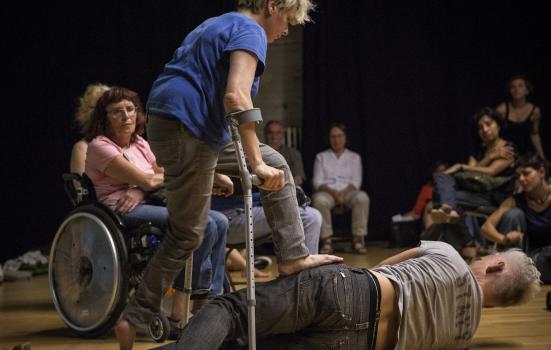All audiences benefit from inclusive design, but most importantly it helps disabled and older people. Jennifer Tomkins and Jo Verrent share tips on how to get it right.

Sven Hagolani
According to the World Health Organization around a billion people (15% of the global population) have some form of impairment, so why would you want to miss out on reaching all these potential audiences? There are always exciting ways to make your events, exhibitions and performances more accessible that help you serve a more diverse audience.
It’s the same with your marketing. Think about your audiences for a moment. Now think about your marketing materials. Can they be opened, read and understood by everyone? Can people find the information they need?
The basics
Improving accessibility is often seen as extra work but the secret is getting it right from the start. Access for disabled people is often about your organisation improving its main marketing materials. It’s not just about alternative formats. Focusing on making all materials short and simple is a great way to begin.
Handwritten fonts are hard to read and italics are not accessible for people with visual impairments or dyslexia
Be careful not to make assumptions. Not all disabled people see themselves as disabled. Often older people, who have impairments in relation to ageing, would never think to look at a page labelled ‘Disability’. Don’t marginalise access information.
If you’re unsure what language to use, ask someone. Consult with actual disabled people. This is not just the key to getting it right but to building audiences too. Ask for feedback and then act on it.
Design, formatting and production
There is sometimes a fear that accessible means ugly when it comes to design, but marketing communications can be both attractive and accessible. Keep designs clear, simple and clutter-free. ‘White space’ is great and boxes and borders can also be used for effective emphasis in print.
Think about the images you use. Images support meaning when chosen well. Illustrate your commitment to equality with images that include disabled people and show off your access provisions. Remember to put text descriptions (‘Alt text’) on images you post online so that screen readers can capture the information.
With limited space in printed materials, strong visuals are often accompanied by tiny text. Don’t make it too small – 12pt is the absolute minimum font recommended, with 14pt being advisable. Commit to a readable size and you’ll soon improve your ability to write succinct copy.
Be careful not to undermine your accessible design with formatting choices. Handwritten fonts are hard to read and italics are not accessible for people with visual impairments or dyslexia. Almost two million people in the UK live with sight loss and 10% of the population have dyslexia – a huge potential audience to exclude.
Accessible formats
Making your existing marketing materials more accessible is a great first step but you still need to provide alternative formats. You are required by law to do this (under the Equality Act 2010). Make sure you know which formats you can supply and how long it will take you to produce them.
Large print and audio versions are easy to produce in-house. Record your own audio versions simply as mp3 files, which can be downloaded from your website. You can also buy the kit and produce Braille in-house or you can use an agency to help you. Search online for ‘text to Braille translation’.
Invite people to ask for different formats and try not to make it sound like a chore. “Please ask us for this information in alternative formats” is more inviting than “This information is available in alternative formats upon request”.
Quick checks
If you’re not sure how accessible your marketing materials are, try these quick checks:
- Easy English: Test the reading age of your copy for free in Microsoft Word by checking the Flesch-Kincaid grade level. This shows you the school year your writing is suitable for. You should aim for 8 on the Flesch-Kincaid scale, which is the average reading age of 13 years old.
- Test your website: Check out the Worldwide Web Consortium’s (WC3) Web Accessibility Initiative and test your existing website with its evaluation tools.
- See how it feels: Try using your website without a mouse or with a voice or text browser (free options available online). How was the experience?
- Ask: Consult with actual disabled people – ask for their feedback and act on it.
Performing these checks may uncover new challenges. Your English may not be as easy as you thought or your website may be harder to navigate than you’d ever imagined. Once you know your strengths and weaknesses, you can start making changes. You might just open up your organisation to a whole new audience. 15% of the population is a huge potential audience to ignore.
Jennifer Tomkins is Head of Marketing and Development at Artsadmin and Jo Verrent is Senior Producer at Unlimited.
www.artsadmin.co.uk
weareunlimited.org.uk
This is a summary of An Accessible Marketing Guide, available at CultureHive.





